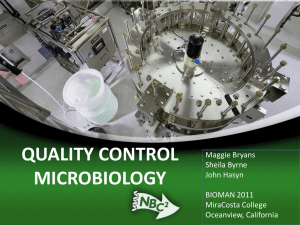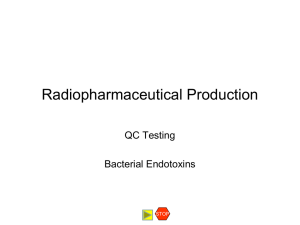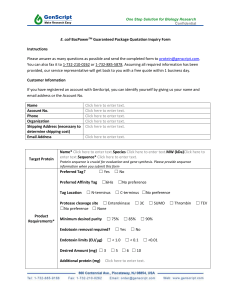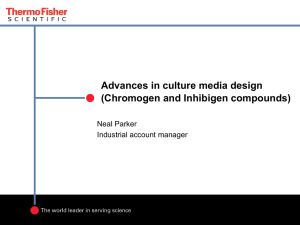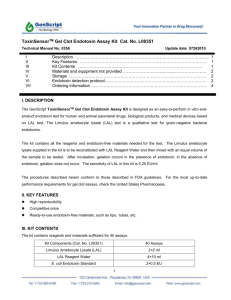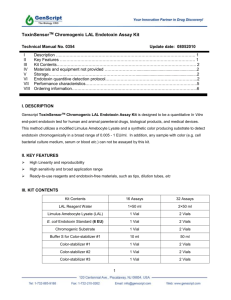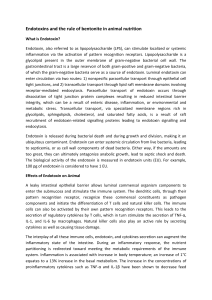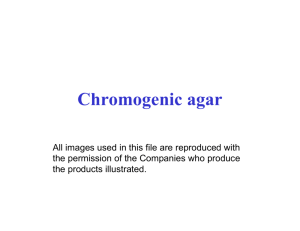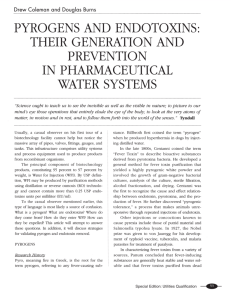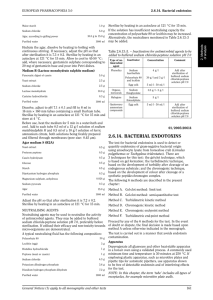Comparison of Endotoxin Testing Methods for Pharmaceutical
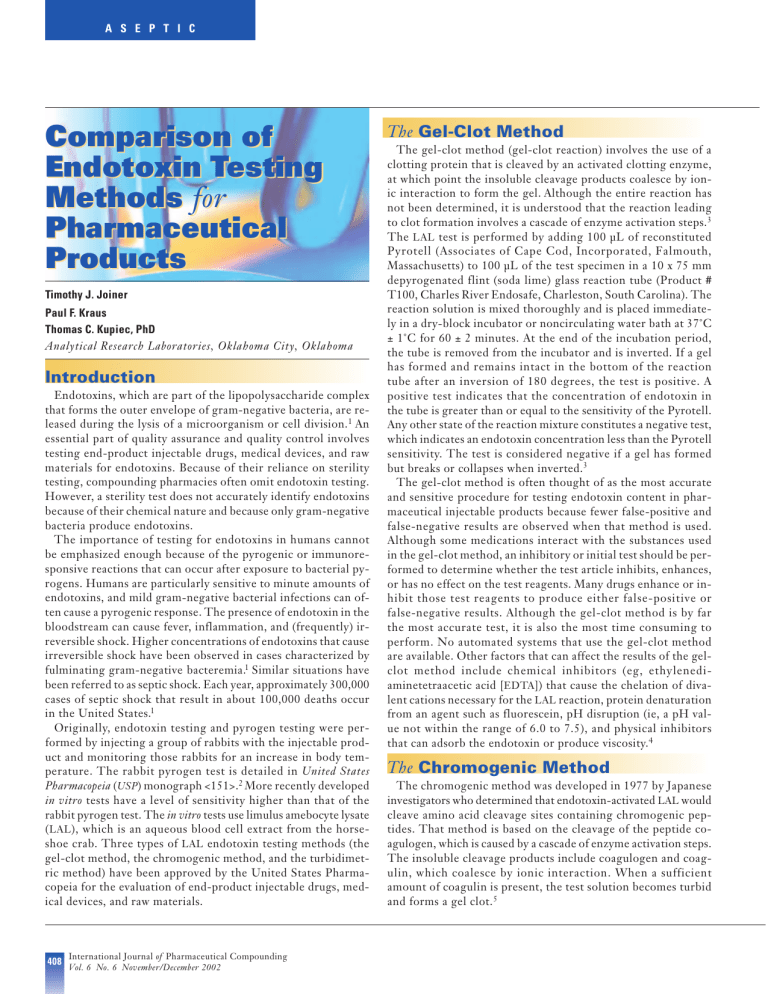
A S E P T I C
Methods
for
Timothy J. Joiner
Paul F. Kraus
Thomas C. Kupiec, PhD
Analytical Research Laboratories, Oklahoma City, Oklahoma
Introduction
Endotoxins, which are part of the lipopolysaccharide complex that forms the outer envelope of gram-negative bacteria, are released during the lysis of a microorganism or cell division.
1 An essential part of quality assurance and quality control involves testing end-product injectable drugs, medical devices, and raw materials for endotoxins. Because of their reliance on sterility testing, compounding pharmacies often omit endotoxin testing.
However, a sterility test does not accurately identify endotoxins because of their chemical nature and because only gram-negative bacteria produce endotoxins.
The importance of testing for endotoxins in humans cannot be emphasized enough because of the pyrogenic or immunoresponsive reactions that can occur after exposure to bacterial pyrogens. Humans are particularly sensitive to minute amounts of endotoxins, and mild gram-negative bacterial infections can often cause a pyrogenic response. The presence of endotoxin in the bloodstream can cause fever, inflammation, and (frequently) irreversible shock. Higher concentrations of endotoxins that cause irreversible shock have been observed in cases characterized by fulminating gram-negative bacteremia.
1 Similar situations have been referred to as septic shock. Each year, approximately 300,000 cases of septic shock that result in about 100,000 deaths occur in the United States.
1
Originally, endotoxin testing and pyrogen testing were performed by injecting a group of rabbits with the injectable product and monitoring those rabbits for an increase in body temperature. The rabbit pyrogen test is detailed in United States
Pharmacopeia ( USP ) monograph <151>.
2 More recently developed in vitro tests have a level of sensitivity higher than that of the rabbit pyrogen test. The in vitro tests use limulus amebocyte lysate
( LAL ), which is an aqueous blood cell extract from the horseshoe crab. Three types of LAL endotoxin testing methods (the gel-clot method, the chromogenic method, and the turbidimetric method) have been approved by the United States Pharmacopeia for the evaluation of end-product injectable drugs, medical devices, and raw materials.
The
Gel-Clot Method
The gel-clot method (gel-clot reaction) involves the use of a clotting protein that is cleaved by an activated clotting enzyme, at which point the insoluble cleavage products coalesce by ionic interaction to form the gel. Although the entire reaction has not been determined, it is understood that the reaction leading to clot formation involves a cascade of enzyme activation steps.
3
The LAL test is performed by adding 100 µL of reconstituted
Pyrotell (Associates of Cape Cod, Incorporated, Falmouth,
Massachusetts) to 100 µL of the test specimen in a 10 x 75 mm depyrogenated flint (soda lime) glass reaction tube (Product #
T100, Charles River Endosafe, Charleston, South Carolina). The reaction solution is mixed thoroughly and is placed immediately in a dry-block incubator or noncirculating water bath at 37˚C
± 1˚C for 60 ± 2 minutes. At the end of the incubation period, the tube is removed from the incubator and is inverted. If a gel has formed and remains intact in the bottom of the reaction tube after an inversion of 180 degrees, the test is positive. A positive test indicates that the concentration of endotoxin in the tube is greater than or equal to the sensitivity of the Pyrotell.
Any other state of the reaction mixture constitutes a negative test, which indicates an endotoxin concentration less than the Pyrotell sensitivity. The test is considered negative if a gel has formed but breaks or collapses when inverted.
3
The gel-clot method is often thought of as the most accurate and sensitive procedure for testing endotoxin content in pharmaceutical injectable products because fewer false-positive and false-negative results are observed when that method is used.
Although some medications interact with the substances used in the gel-clot method, an inhibitory or initial test should be performed to determine whether the test article inhibits, enhances, or has no effect on the test reagents. Many drugs enhance or inhibit those test reagents to produce either false-positive or false-negative results. Although the gel-clot method is by far the most accurate test, it is also the most time consuming to perform. No automated systems that use the gel-clot method are available. Other factors that can affect the results of the gelclot method include chemical inhibitors (eg, ethylenediaminetetraacetic acid [ EDTA ]) that cause the chelation of divalent cations necessary for the LAL reaction, protein denaturation from an agent such as fluorescein, pH disruption (ie, a pH value not within the range of 6.0 to 7.5), and physical inhibitors that can adsorb the endotoxin or produce viscosity.
4
The
Chromogenic Method
The chromogenic method was developed in 1977 by Japanese investigators who determined that endotoxin-activated LAL would cleave amino acid cleavage sites containing chromogenic peptides. That method is based on the cleavage of the peptide coagulogen, which is caused by a cascade of enzyme activation steps.
The insoluble cleavage products include coagulogen and coagulin, which coalesce by ionic interaction. When a sufficient amount of coagulin is present, the test solution becomes turbid and forms a gel clot.
5
408
International Journal of Pharmaceutical Compounding
Vol. 6 No. 6 November/December 2002
A S E P T I C
In the presence of endotoxin, the components of LAL are activated in a proteolytic cascade that results in the cleavage of a colorless artificial peptide substrate present in Pyrochrome
LAL . Proteolytic cleavage of the substrate liberates p-nitroaniline
(p NA ), which is yellow and has an absorbance of 405 nm. The test is performed by adding a volume of Pyrochrome to a volume of specimen and incubating that reaction mixture at 37˚C.
The higher the endotoxin concentration in the specimen, the faster the production of p NA .
5 When the chromogenic method is used, two methods of quantifying the endotoxin concentration in the sample are available. The kinetic method relies on the amount of time required for the sample to reach a particular absorbance
(405 nm). The onset time is determined by the concentration of endotoxin in the sample. For example, a shorter reaction interval indicates a higher endotoxin concentration in the sample.
In the endpoint chromogenic method, the measurement of p NA after a set incubation period is used to determine the endotoxin concentration. Both the kinetic method and the endpoint chromogenic method require a standard curve to determine the endotoxin quantities present in the sample.
The advantages of using the chromogenic method are many.
There are automated systems available that decrease the amount of time required to perform the test (and therefore increase the number of tests that can be performed). When many tests for endotoxins must be performed, an automated chromogenic method is the best solution. That method is very user-friendly, and the results can be calculated easily. Caution should be taken when substances that denature proteins, chelate ions, bind endotoxins, or alter the hydrophobic state of endotoxins are tested; those substances may interfere with the test. Some serine proteases (eg, trypsin, activated blood factors) cause a falsepositive result unless they have been denatured by heat before testing. Animal serum, albumin, plasma, and other substances may interfere with p NA -based chromogenic assays because of their yellow color. Excess turbidity in a sample may also interfere with the test, unless the turbidity can be subtracted from the blank or the sample can be treated to remove the turbidity.
5
The
Turbidimetric Method
The turbidimetric method is somewhat analogous to the chromogenic method and requires similar calculations. The sequence of events that occurs in the turbidimetric method, which is comparable to that of the gel-clot and chromogenic methods, is unknown with the exception of the final step. That step involves the cleavage of a clotting protein by an activated clotting enzyme. The cleavage products coalesce as a result of ionic interactions that occur after the cleavage and cause the reaction mixture to become turbid.
6
The turbidimetric method can be used to determine the endotoxin content of a sample in two ways. Both require the use of a standard curve but differ in the endpoint for measurement.
The endotoxin concentration can be determined by using optical density measurements to compare the sample with authentic standards to measure the rate of increase in turbidity, the duration of time until the desired turbidity level is achieved, or the extent of turbidity after a defined incubation period.
An automated system that aids throughput is available for this method as well as the chromogenic method. Like the chromogenic method, the turbidimetric method can be altered by testing blood, serum, albumin, plasma, and similar materials.
The turbidimetric method is sensitive to suspended or turbid materials and can result in a false positive if the sample is not prepared correctly. Trypsin is another example of a sample that, when tested, can cause a false-positive result unless the sample is properly denatured.
6
Conclusion
All three endotoxin-testing methods described in this article have been approved by the USP for use with injectable drugs and other products. Although each method has advantages and disadvantages, all can be used to accurately and effectively determine the presence of endotoxins in various products. Many scientists believe that the gel-clot method is the most accurate method of determining endotoxin content. When the gel-clot method is used, fewer interactions that can inhibit the reaction occur, but the long preparation process can delay results. The turbidimetric method can be performed with an automated system. It is also easy to perform, but many individuals feel that false-positive results often occur when that method is used.
The chromogenic method is very user-friendly and can be performed with an automated system, but many compounds can interact when that method is used. As a result, the chromogenic method cannot be used in many cases. In addition to the drawbacks of each of these three methods recommended by the USP , errors made by technicians and the misinterpretation of results are also common problems. Regardless of which method is used, laboratories and pharmacies should ensure that their technicians are well trained and educated in the endotoxin testing method of choice.
References
1. Volk WA, Gebhardt BM, Hammarskjold ML, et al, eds. In: Essentials of Medical Microbiology . 5th ed. Philadelphia, PA:Lippincott-Raven Publishers;
1996:47, 327.
2. US Pharmacopeial Convention, Inc. United States Pharmacopeia XXIV/
National Formulary 19 . Rockville, MD:US Pharmacopeial Convention, Inc;
1999:1914.
3. Pyrotell (Limulus Amebocyte Lysate [LAL] Products) [product information].
Falmouth, MA:Associates of Cape Cod Incorporated; 1997.
4. [No author listed.] Bacterial endotoxins/pyrogens. In: Inspector’s Technical Guide . Rockville, MD:United States Food and Drug Administration,
Department of Health and Human Services; 1997.
5. Pyrochrome (Limulus Amebocyte Lysate [LAL] Products) [product information]. Falmouth, MA:Associates of Cape Cod Incorporated; 1997.
6. Pyrotell-T (Limulus Amebocyte Lysate [LAL] Products) [product information]. Falmouth, MA:Associates of Cape Cod Incorporated; 1997.
Address correspondence to: Timothy J. Joiner, Senior Microbiologist, Analytical Research Laboratories, 840 Research Parkway, Suite 546, Oklahoma City, OK 73104. E-mail: tjoiner
@arlok.com
■
International Journal of Pharmaceutical Compounding
Vol. 6 No. 6 November/December 2002
409
